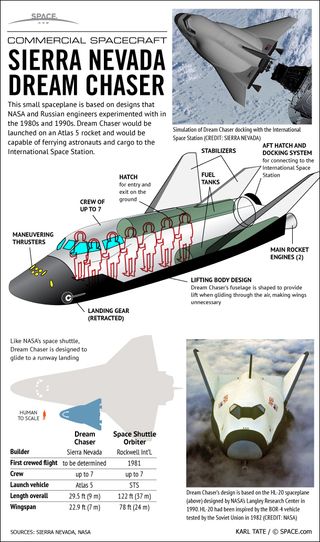Sierra Nevada Clears Dream Chaser Space Plane Test Milestone
WASHINGTON — Sierra Nevada Corporation (SNC) announced Jan. 5 that NASA has confirmed that the company's Dream Chaser vehicle passed a key milestone during its November free flight test.
In a statement, SNC said that NASA concluded that the Nov. 11 free flight of the Dream Chaser engineering test article, at Edwards Air Force Base in California, met or exceeded all the requirements of the company’s last remaining funded milestone in its Commercial Crew Integrated Capability (CCiCap) award from 2012.
During the flight test, the Dream Chaser was released from a helicopter at an altitude of about 3,750 meters and glided to an autonomous runway landing 60 seconds later, reaching a top speed of 530 kilometers per hour during its descent. [In Pictures: Sierra Nevada's Dream Chaser Aces Glide Test Flight]

The company said in a call with reporters two days after the flight that it went as planned, but needed to wait for NASA to verify that assessment, which the agency has now done.
"The test was a huge success and when we looked at the data, we were thrilled to see how closely our flight performance projections matched the actual flight data," Steve Lindsey, vice president of space exploration systems at SNC, said in a statement about the milestone approval. "This gives us high confidence in our atmospheric flight performance as we move towards orbital operations."

The milestone, formally known as Milestone 4B, was the last funded milestone in the CCiCap Space Act Agreement that SNC received from NASA in August 2012. The milestone is valued at $8 million, according to NASA documentation. The company has added additional unfunded milestones to that agreement, which SNC and NASA extended last year for five years, to support potential future development of a crewed version of Dream Chaser.
SNC now, though, is focused on developing the version of Dream Chaser that will transport cargo to and from the International Space Station under a Commercial Resupply Services 2 contract awarded to SNC in January 2016. A critical design review for that version of the vehicle is scheduled for the middle of this year, although elements of the first orbital vehicle are already under construction to support a first launch in 2020.
Get the Space.com Newsletter
Breaking space news, the latest updates on rocket launches, skywatching events and more!
After the November flight, SNC executives said that, if NASA agreed the flight met the milestone requirements, the vehicle would be put into storage. "If we have all the data that we needed from the test, and if NASA concludes that with us, the vehicle will not need any further flight tests," Mark Sirangelo, corporate vice president of SNC’s Space Systems unit, said at the time.
Sirangelo, in the statement, noted that the successful flight took place just after the 70th anniversary of the first supersonic aircraft flight and the 40th anniversary of the final shuttle approach and landing test flight, both hosted at Edwards. "With that historic legacy, I would like to extend our sincere appreciation to our whole flight team," he said.
This story was provided by SpaceNews, dedicated to covering all aspects of the space industry.
Join our Space Forums to keep talking space on the latest missions, night sky and more! And if you have a news tip, correction or comment, let us know at: community@space.com.

Jeff Foust is a Senior Staff Writer at SpaceNews, a space industry news magazine and website, where he writes about space policy, commercial spaceflight and other aerospace industry topics. Jeff has a Ph.D. in planetary sciences from the Massachusetts Institute of Technology and earned a bachelor's degree in geophysics and planetary science from the California Institute of Technology. You can see Jeff's latest projects by following him on Twitter.

